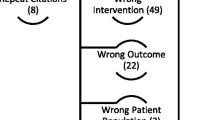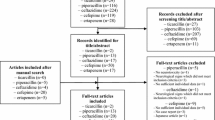Abstract
Purpose
We present the case of a 67-year-old woman with severely reduced renal clearance suffering from ceftazidime-induced encephalopathy. Subsequently, we search the literature to review and describe the neurotoxicity of ceftazidime.
Methods
A search string was developed to search PubMed for relevant cases from which relevant information was extracted. Using the collected data a ROC analysis was performed in R to determine a neurotoxicity threshold.
Results
Our patient suffered from progressive loss of consciousness and myoclonic seizures, with improvements noted a few days after discontinuation of treatment. The dose was not appropriately reduced to take into account her reduced renal function. The highest ceftazidime concentration recorded was 234.9 mg/mL. Using the Naranjo score we found a probable relationship between our patient’s encephalopathy and ceftazidime administration. In the literature we found a total of 32 similar cases, most of which also had some form of renal impairment. Using our collected data and ceftazidime concentrations provided in the literature, a ROC analysis provided a neurotoxicity threshold of 78 mg/L for ceftazidime neurotoxicity.
Conclusion
Ceftazidime-related neurotoxicity is a known issue, especially in patients with severe renal impairment. Yet no concrete toxicity threshold has been reported so far. We propose the first toxicity threshold for ceftazidime of 78 mg/L. Future prospective studies are needed to validate and optimize the neurotoxicity threshold as upper limit for ceftazidime therapeutic drug monitoring.


Similar content being viewed by others
Data availability
The data presented in this study are available on request from the corresponding author. The data are not publicly available due to privacy and ethical reasons.
References
Bassetti M, et al. How to manage Pseudomonas aeruginosa infections. Drugs Context. 2018;7: 212527.
Matesanz M, Mensa J. Ceftazidime-avibactam. Rev Esp Quimioter. 2021;34:38–40.
Richards DM, Brogden RN. Ceftazidime: A review of its antibacterial activity, pharmacokinetic properties and therapeutic use. Drugs. 1985;29:105–61.
Ferrer R, et al. Empiric antibiotic treatment reduces mortality in severe sepsis and septic shock from the first hour: results from a guideline-based performance improvement program. Crit Care Med. 2014;42:1749–55.
Abdul-Aziz MH, et al. Antimicrobial therapeutic drug monitoring in critically ill adult patients: a Position Paper. Intensive Care Med. 2020;46:1127–53.
Guilhaumou R, et al. Optimization of the treatment with beta-lactam antibiotics in critically ill patients-guidelines from the French society of pharmacology and therapeutics (Societe Francaise de pharmacologie et therapeutique-SFPT) and the French society of anaesthesia and intensive care medicine (Societe Francaise d’anesthesie et reanimation-SFAR). Crit Care. 2019;23:104.
Pea F, Viale P, Furlanut M. Antimicrobial therapy in critically ill patients: a review of pathophysiological conditions responsible for altered disposition and pharmacokinetic variability. Clin Pharmacokinet. 2005;44:1009–34.
Arnold CJ, et al. Cefepime and ceftazidime safety in hospitalized infants. Pediatr Infect Dis J. 2015;34:964–8.
Beumier M, et al. Elevated beta-lactam concentrations associated with neurological deterioration in ICU septic patients. Minerva Anestesiol. 2015;81:497–506.
Guo X, et al. Central nervous system adverse events of ceftazidime/avibactam: a retrospective study using food and drug administration adverse event reporting system. J Clin Pharm Ther. 2022;47:2369–72.
Zavrelova A, et al. Superiority of ceftazidime off-label high-dose regimen in PK/PD target attainment during treatment of extensively drug-resistant Pseudomonas aeruginosa infections in cancer patients. Br J Clin Pharmacol. 2022;89:1452–61.
Zavrelova A, et al. Better outcome of off-label high-dose ceftazidime in hemato-oncological patients with infections caused by extensively drug-resistant Pseudomonas aeruginosa. Mediterr J Hematol Infect Dis. 2023;15(1): e2023001.
EUCAST, Clinical breakpoints - breakpoints and guidance, C.b. (v13.1), Editor. 2023: https://www.eucast.org/clinical_breakpoints.
Douglas MA, Quandt CM, Stanley DA. Ceftazidime-induced encephalopathy in a patient with renal impairment. Arch Neurol. 1988;45:936–7.
Slaker RA, Danielson B. Neurotoxicity associated with ceftazidime therapy in geriatric patients with renal dysfunction. Pharmacotherapy. 1991;11:351–2.
Hillsley RE, Massey EW. Truncal asterixis associated with ceftazidime, a third-generation cephalosporin. Neurology. 1991;41:2008.
Jackson GD, Berkovic SF. Ceftazidime encephalopathy: absence status and toxic hallucinations. J Neurol Neurosurg Psychiatry. 1992;55:333–4.
Lye WC, Leong SO. Neurotoxicity associated with intraperitoneal ceftazidime therapy in a CAPD patient. Perit Dial Int. 1994;14:408–9.
Klion AD, et al. Ceftazidime-related nonconvulsive status epilepticus. Arch Intern Med. 1994;154:586–9.
Martinez-Rodriguez JE, et al. Nonconvulsive status epilepticus associated with cephalosporins in patients with renal failure. Am J Med. 2001;111:115–9.
Chow KM, et al. Retrospective review of neurotoxicity induced by cefepime and ceftazidime. Pharmacotherapy. 2003;23:369–73.
Primavera A, Cocito L, Audenino D. Nonconvulsive status epilepticus during cephalosporin therapy. Neuropsychobiology. 2004;49:218–22.
Vannaprasaht S, et al. Ceftazidime overdose-related nonconvulsive status epilepticus after intraperitoneal instillation. Clin Toxicol (Phila). 2006;44:383–6.
Martin MG. Encephalopathy with myoclonic jerks resulting from ceftazidime therapy: an under-recognized potential side-effect when treating febrile neutropenia. Leuk Lymphoma. 2007;48:413–4.
Misra UK, et al. Association of antibiotics with status epilepticus. Neurol Sci. 2013;34:327–31.
Joseph J, Vimala A. Ceftazidime-induced myoclonus and encephalopathy in hemodialysis patient. Indian J Nephrol. 2015;25:61–2.
Ong CY, Qin Y. Myoclonus from antibiotic therapy (ceftazidime-induced neurotoxicity): a case report and review. Cureus. 2018;10: e2250.
Rodríguez-Núñez O, et al. Evaluation of ceftazidime/avibactam for serious infections due to multidrug-resistant and extensively drug-resistant Pseudomonas aeruginosa. J Glob Antimicrob Resist. 2018;15:136–9.
Al-Sadawi M, et al. Jerky movement with ceftazidime: a case of ceftazidime-induced neurotoxicity with a review of the literature. Case Rep Med. 2019;2019:8936478.
Amirouche L, et al. Ceftazidime-induced neurotoxicity in an 80-year-old female with renal dysfunction: a case report. J Pharm Pract. 2022;35:482–7.
Toda M, et al. Ceftazidime encephalopathy developed without the elevation of cerebrospinal fluid concentration of ceftazidime: a case report of two cases. J Infect Chemother. 2022;28:1667–71.
Robosa RS, et al. Ceftazidime plasma concentrations and neurotoxicity: the importance of therapeutic drug monitoring in patients undergoing different modalities of renal replacement therapy: a grand round. Ther Drug Monit. 2023;45:711–3.
Chan S, et al. Cephalosporin-induced myoclonus. Neurology. 2006;66:E20.
Haldar R, et al. Convulsions following rapid ceftazidime administration for preinduction antibiotic prophylaxis during neurosurgical procedure. Anesth Essays Res. 2015;9:427–9.
Collins RD, et al. Probable nonconvulsive status epilepticus with the use of high-dose continuous infusion ceftazidime. J Pharm Pract. 2016;29:564–8.
Minh Nguyen K, et al. Focal seizures with a migrating aspect in infants treated with beta-lactam antibiotics: report of two cases. Neurophysiol Clin. 2020;50:81–6.
Pingue V, et al. Ceftazidime/avibactam neurotoxicity in an adult patient with normal renal function. Clin Microbiol Infect. 2020;27:795–6.
Robin X, et al. pROC: an open-source package for R and S+ to analyze and compare ROC curves. BMC Bioinform. 2011;12:77.
Adverse Drug Reaction Probability Scale (Naranjo) in Drug Induced Liver Injury, in LiverTox: Clinical and Research Information on Drug-Induced Liver Injury. 2012, National Institute of Diabetes and Digestive and Kidney Diseases: Bethesda (MD).
Bhattacharyya S, et al. Antibiotic-associated encephalopathy. Neurology. 2016;86:963–71.
Wanleenuwat P, Suntharampillai N, Iwanowski P. Antibiotic-induced epileptic seizures: mechanisms of action and clinical considerations. Seizure. 2020;81:167–74.
Roger C, Louart B. Beta-lactams toxicity in the intensive care unit: an underestimated collateral damage? Microorganisms. 2021;9:1505.
Barreto EF, et al. Setting the beta-lactam therapeutic range for critically ill patients: is there a floor or even a ceiling? Crit Care Explor. 2021;3: e0446.
Joshua L, Devi P, Guido S. Adverse drug reactions in medical intensive care unit of a tertiary care hospital. Pharmacoepidemiol Drug Saf. 2009;18:639–45.
Cojutti PG, et al. Population pharmacokinetics of continuous-infusion ceftazidime in febrile neutropenic children undergoing HSCT: implications for target attainment for empirical treatment against Pseudomonas aeruginosa. J Antimicrob Chemother. 2019;74:1648–55.
Aubert G, et al. Prospective determination of serum ceftazidime concentrations in intensive care units. Ther Drug Monit. 2010;32:517–9.
Lutsar I, Friedland IR. Pharmacokinetics and pharmacodynamics of cephalosporins in cerebrospinal fluid. Clin Pharmacokinet. 2000;39:335–43.
Funding
The authors did not receive support from any organization for the submitted work.
Author information
Authors and Affiliations
Contributions
Conceptualization: DV, MG, IS; methodology: DV, MG; data curation: DV, MG, IS; writing—original draft preparation: DV, MG, IS; writing—review and editing: DV, MG, JM, WP, YD, JW, IS. All authors have read and agreed to the published version of the manuscript.
Corresponding author
Ethics declarations
Conflict of interest
The authors have no competing interests to declare that are relevant to the content of this article.
Ethical approval
Approval was obtained from the ethics committee of KU Leuven (S68320). The procedures used in this study adhere to the tenets of the Declaration of Helsinki.
Informed consent
Informed consent was obtained from the patient in accordance with the local ethics committee policy.
Supplementary Information
Below is the link to the electronic supplementary material.
Rights and permissions
Springer Nature or its licensor (e.g. a society or other partner) holds exclusive rights to this article under a publishing agreement with the author(s) or other rightsholder(s); author self-archiving of the accepted manuscript version of this article is solely governed by the terms of such publishing agreement and applicable law.
About this article
Cite this article
Vanneste, D., Gijsen, M., Maertens, J. et al. Ceftazidime-related neurotoxicity in a patient with renal impairment: a case report and literature review. Infection 52, 1113–1123 (2024). https://doi.org/10.1007/s15010-023-02167-9
Received:
Accepted:
Published:
Issue Date:
DOI: https://doi.org/10.1007/s15010-023-02167-9




